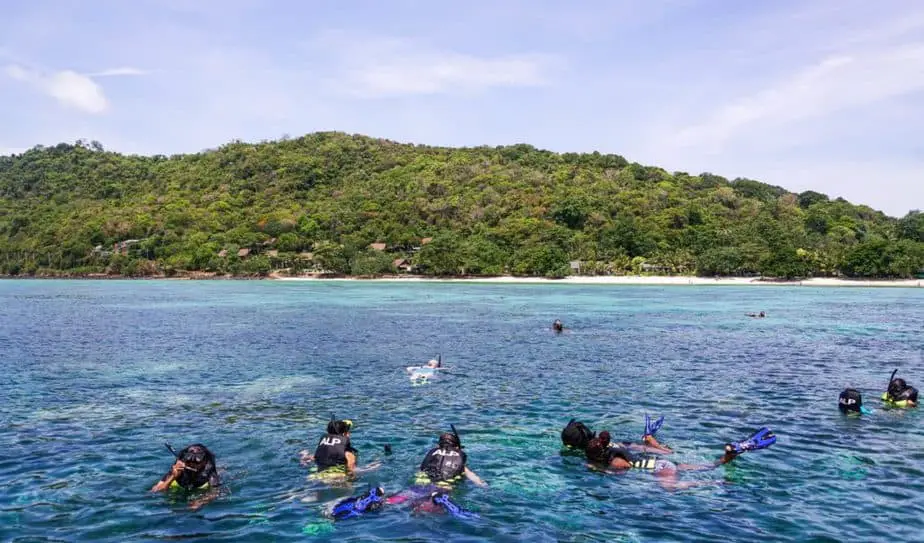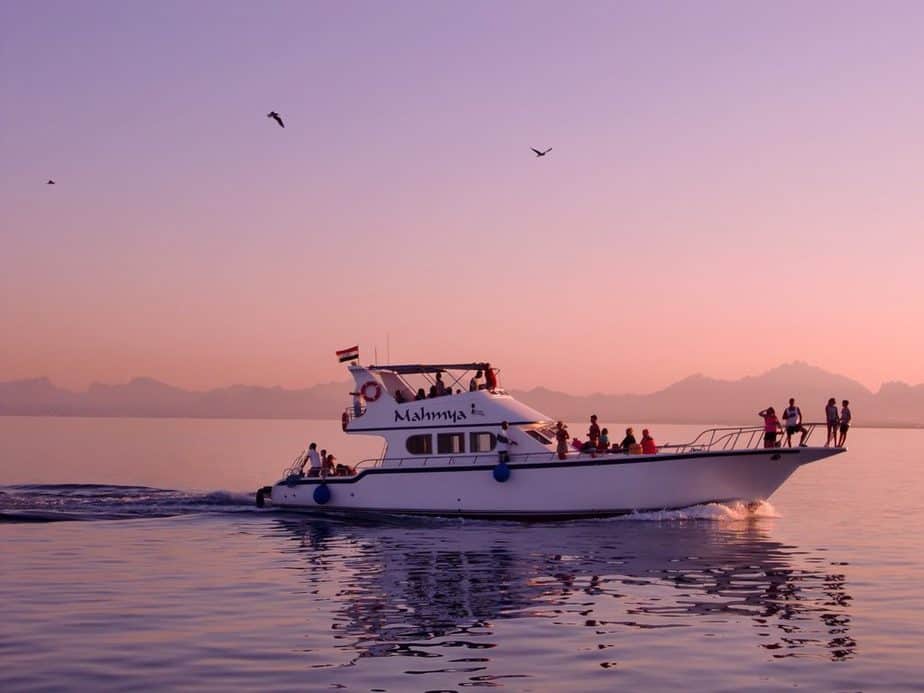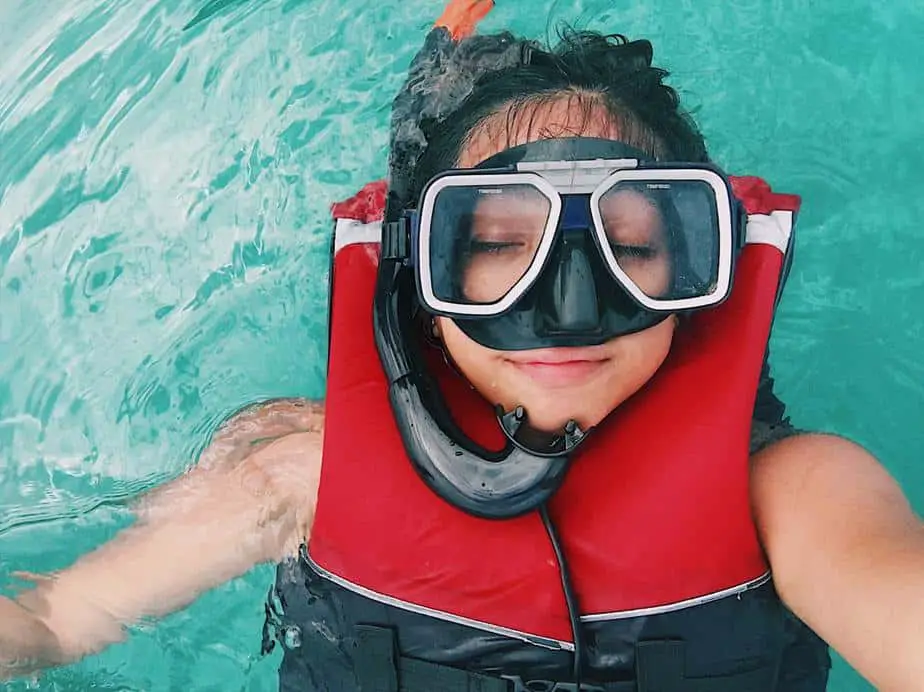Is it possible to snorkel if you don’t know how to swim? While the answer is potentially yes, in our opinion we strongly recommend you learn how to swim before you go snorkeling. We want to err on the side of caution and say that, for safety reasons, if you are a non-swimmer then knowing how to swim is essential just in case any trouble occurs in the water.
You don’t have to be a strong swimmer (this isn’t a competition, after all), but having basic swimming competency like knowing how to float or do the doggy paddle will drastically reduce the danger. Knowing how to swim will make snorkeling much easier. In this article, we go over the reasons why knowing how to swim is important for snorkeling, as well as discuss ways a non-swimmer can potentially snorkel safely.
Is Swimming Required for Snorkeling?
Again, if you don’t know how to swim, we feel it is not safe to snorkel in water that is much deeper than your height, let alone out in the open water by boat. All it takes is a strong current or an injury and all of a sudden you could be caught up in a life-or-death situation. But before we even get that far, and to tone down the drama a bit, let’s talk about something even more basic.
Fundamentally, snorkeling requires you to know how to float along the water’s surface with your face submerged in the water. This is what snorkeling is and is how it works whether you are wearing fins or not. Most snorkelers, ourselves included, like to snorkel with fins. If you are not a strong swimmer, know that snorkeling with fins makes the activity so much easier.
With fins, you can propel yourself through the water much more easily, which saves your energy. If you want to quickly dive down for a bit, which is known as duck diving, fins help you dive down effortlessly as well. So at the very least, you should know basic swimming skills, and with the assistance of some snorkeling gear, you can safely snorkel. It is up to you to judge your swimming skills and what you are capable of, but please err on the side of caution.
Snorkeling Tips for Beginners and Non-Swimmers
Don’t Panic
When you’re in deep enough water that you can’t see the bottom anymore, and far enough away from land that you might not be able to make it back to shore without assistance, you might feel an overwhelming sense of panic. However, panicking is the worst thing you can do, especially if you’re a non-swimmer. If you panic, your breathing will be in disarray and you could be wasting valuable energy thrashing about.
The most common cause of panic is when water starts to fill your snorkel mask. This often happens because the seal on your mask is not tight enough and you don’t have a good snorkel mask for beards. Once water starts to fill, calmly surface, drain the water, and continue snorkeling.
Staying calm on the other hand accomplishes many goals. If nothing else, you will be aware of your situation and your breathing will be normal. You will be able to think rationally, and discern whether you’re actually in any trouble or not. Keep in mind that if you don’t know how to swim, you’re definitely wearing some kind of flotation device as well as snorkeling with others so it is unlikely you’ll plummet to the bottom of the sea despite your fears.
Use a Flotation Device
There are many flotation devices that you can use out in the water, and some of them are even designed specifically with snorkeling in mind. There are many to choose from such as snorkeling vests, flotation belts, boogie boards, pool noodles, thick wetsuits and of course standard life jackets. Keep in mind that out of all of these flotation devices, only the life jacket is approved by the United States Coast Guard (USCG) as a life-saving device. If you absolutely do not know how to swim, you must wear a life jacket.
The other flotation devices provide a certain amount of buoyancy. Before purchasing one, look up its weight rating to see how much weight the specific device can support. Furthermore, do not rely entirely on the flotation device to keep you afloat. You should still know how to paddle or stay afloat on your own, and use the flotation devices to assist you and conserve energy. We recommend using a flotation belt, snorkel vest, or life jacket as these devices are strapped onto you and will not slip away, unlike boogie boards or pool noodles.
Float Horizontally
When you don’t know how to swim, your natural instinct while in the water is to try to get as much of your body out of the water. However, that is not a good way to float, and you should instead lower your body into the water and then get as horizontal as you can. With the help of a flotation device, lower your chest and keep the water around your chin or neck level. This will help you stay buoyant more than trying to push upwards as if you were trying to jump out of the water.

Control Your Breathing
We covered this briefly in our “don’t panic” section. The first time you snorkel, you will understandably be nervous, particularly if you are not confident in your swimming skills. Your breathing and heart rate will be elevated. Calm down and focus on what’s important which is ensuring that your gear is working and you’re doing the right snorkeling techniques.
First, your snorkel mask and mouthpiece should have a tight seal on your face. If you have a beard or mustache, then this may cause water leaks because the mask skirt will not seal tightly around facial hair. Best to follow the advice in this guide or just shave it off.
Next, breathe through your mouth and not your nose. If you have a mask with a purge system, you can exhale through your nose to expel any water that might have entered. Remember that the snorkel is above water providing you fresh air, so you can breath as you normally would while enjoying the underwater views.
Submerge Just a Little
Snorkeling only requires you to submerge the front part of your face and goggles underwater. You don’t need to fully submerge; pretty much half of your body will be above water, especially with a flotation device on. All you need to do is break the water’s surface with your mask and you can see what the sea has in store for you.
Furthermore, this will reduce the chances of you lowering the top part of the snorkel into the water and gulping down a mouthful of seawater. Choking on water can be panic inducing, and so this is something we want to avoid. After some time water may enter your mask because of a weak seal, but all you need to do is drain the water and resume snorkeling.
Snorkel with a Buddy
Take a buddy with you who is a strong swimmer. That way, you can have somebody to watch your back that can help you or call for help in case there is any trouble. Besides, it’s more fun to do things with somebody else, and in this case a snorkeling buddy could literally save your life. With that said, we still recommend you learn how to swim on your own, otherwise if you panic there is a possibility that you will endanger your buddy as well.
Currents and Rip Tides
Whether you are a beginner at snorkeling or a veteran, you must be wary of currents and rip tides. It can happen very suddenly; one second you’re leisurely snorkeling, and the next you’re swept out into the sea. This is why we recommend wearing a buoyancy aid that can be strapped onto you, such as a life vest or snorkel vest. A boogie board or pool noodle could easily be lost in this scenario.
In this situation, you must not panic. Your life vest will keep you afloat, so you won’t be in any immediate danger, however it will not save you from getting swept further out. What you do in this case is not to swim directly to shore, but rather to swim parallel to the shore. There is no point swimming against the current, you will just waste precious energy. If you swim parallel to the shore, at some point, you will break free from the current or riptide, and then you can swim directly to shore.

Beach vs. Boat Snorkeling
Snorkeling can be done from the beach or from a boat, often as part of a tour. There are pros and cons to each of these if you’re a non-swimmer.
From the Beach
Snorkeling from the beach sounds like the safer option for a non-swimmer, however that isn’t necessarily the case. When you snorkel from a boat, you enter deep water immediately and are on high alert from the get go. On the other hand, snorkeling from the beach can give you a false sense of security.
While there’s less pressure since you can start from shallow water and go at your own pace, all it takes is a strong current or riptide to drag you to deep waters. That is why even if you are in shallow water where your feet can touch the bottom, you should still be wearing a buoyancy aid just in case something like that happens.
Another downside of snorkeling from the beach is that you may not have an experienced snorkeling instructor to help you. They are often working as part of a tour guide, and on boat trips you can simply let the instructor know that you are not a strong swimmer.
If you plan on snorkeling from the beach, make sure to do so where a lifeguard is close by, and try to find a buddy who is a strong swimmer to snorkel with you. Depending on where you go, you can still see a surprising amount of marine life even in shallow water.
From a Boat
If you have some cash to spare, non-swimmers should consider snorkeling as part of a boat trip. Boat trips will provide you with experienced instructors, flotation devices, and a group of people to snorkel with. Let the instructor know you’re a non-swimmer so that they can give you additional guidance and keep a close watch on you.
With that said, if you snorkel from a boat you will enter deep water immediately. You don’t have many options to go at your own pace, you’re literally diving into the deep end. However, just follow the instructor’s tips, wear a life vest, and stay close to the group and you’ll manage.
Parting Words
If you don’t know how to swim, snorkeling can be a horrifying experience with how far out you’ll be from land. We highly recommend you learn the basics of how to swim before attempting to snorkel. However, it is possible for non-swimmers to snorkel with the help of a flotation device and a snorkeling buddy.
An easy way to get all of this started is to go on a tour and to convince a friend or two to join you. You get to go on a nice vacation, you get instructions and guidance, and tons of people to snorkel with that can look out for you if anything goes wrong.


